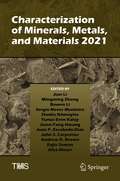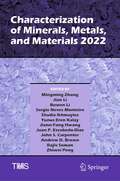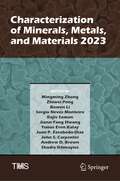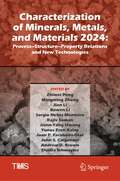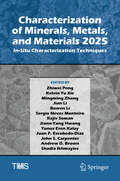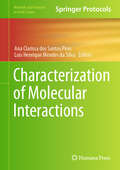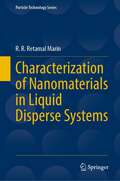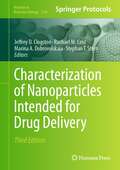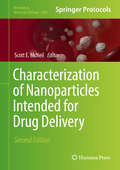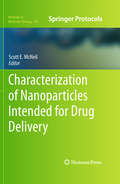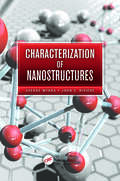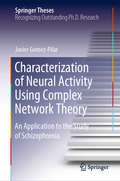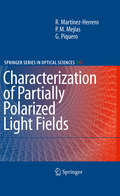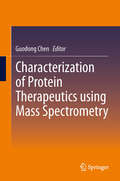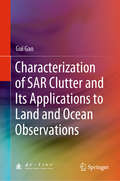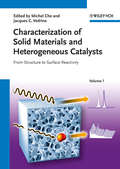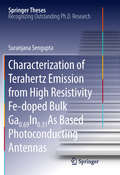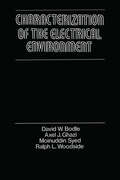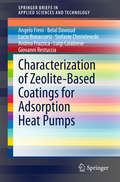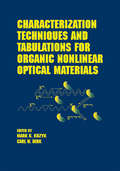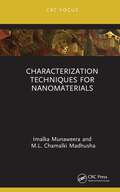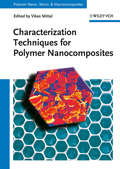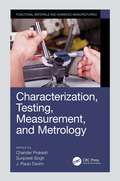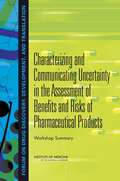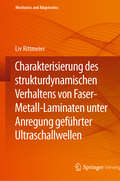- Table View
- List View
Characterization of Minerals, Metals, and Materials 2021 (The Minerals, Metals & Materials Series)
by Jian Li Mingming Zhang Bowen Li Sergio Neves Monteiro Shadia Ikhmayies Yunus Eren Kalay Jiann-Yang Hwang Juan P. Escobedo-Diaz John S. Carpenter Andrew D. Brown Rajiv Soman Alex MoserThe collection focuses on the advancements of characterization of minerals, metals, and materials and the applications of characterization results on the processing of these materials. Advanced characterization methods, techniques, and new instruments are emphasized. Areas of interest include, but are not limited to: · Novel methods and techniques for characterizing materials across a spectrum of systems and processes. · Characterization of mechanical, thermal, electrical, optical, dielectric, magnetic, physical, and other properties of materials. · Characterization of structural, morphological, and topographical natures of materials at micro- and nano- scales. · Characterization of extraction and processing including process development and analysis. · Advances in instrument developments for microstructure analysis and performance evaluation of materials, such as computer tomography (CT), X-ray and neutron diffraction, electron microscopy (SEM, FIB, TEM), and spectroscopy (EDS, WDS, EBSD) techniques. · 2D and 3D modelling for materials characterization. The book explores scientific processes to characterize materials using modern technologies, and focuses on the interrelationships and interdependence among processing, structure, properties, and performance of materials.
Characterization of Minerals, Metals, and Materials 2022 (The Minerals, Metals & Materials Series)
by Jian Li Jiann-Yang Hwang Shadia Ikhmayies John S. Carpenter Sergio Neves Monteiro Mingming Zhang Bowen Li Zhiwei Peng Juan P. Escobedo-Diaz Yunus Eren Kalay Rajiv Soman Andrew D. BrownThe collection focuses on the advancements of characterization of minerals, metals, and materials and the applications of characterization results on the processing of these materials. Advanced characterization methods, techniques, and new instruments are emphasized. Areas of interest include, but are not limited to: • Novel methods and techniques for characterizing materials across a spectrum of systems and processes. • Characterization of mechanical, thermal, electrical, optical, dielectric, magnetic, physical, and other properties of materials. • Characterization of structural, morphological, and topographical natures of materials at micro- and nano- scales. • Characterization of extraction and processing including process development and analysis. • Advances in instrument developments for microstructure analysis and performance evaluation of materials, such as computer tomography (CT), X-ray and neutron diffraction, electron microscopy (SEM, FIB, TEM), and spectroscopy (EDS, WDS, EBSD) techniques. • 2D and 3D modelling for materials characterization.
Characterization of Minerals, Metals, and Materials 2023 (The Minerals, Metals & Materials Series)
by Mingming Zhang Zhiwei Peng Bowen Li Sergio Neves Monteiro Rajiv Soman Jiann-Yang Hwang Yunus Eren Kalay Juan P. Escobedo-Diaz John S. Carpenter Andrew D. Brown Shadia IkhmayiesThe collection focuses on the advancements of characterization of minerals, metals, and materials and the applications of characterization results on the processing of these materials. Advanced characterization methods, techniques, and new instruments are emphasized. Areas of interest include, but are not limited to:· Extraction and processing of various types of minerals, process-structure-property relationship of metal alloys, glasses, ceramics, polymers, composites, semiconductors, and carbon using as functional and structural materials. · Novel methods and techniques for characterizing materials across a spectrum of systems and processes. · Characterization of mechanical, thermal, electrical, optical, dielectric, magnetic, physical, and other properties of materials. · Characterization of structural, morphological, and topographical natures of materials at micro- and nano- scales. · Characterization of extraction and processing including process development and analysis. · Advances in instrument developments for microstructure analysis and performance evaluation of materials, such as computer tomography (CT), X-ray and neutron diffraction, electron microscopy (SEM, FIB, TEM), and spectroscopy (EDS, WDS, EBSD) techniques. · 2D and 3D modelling for materials characterization.
Characterization of Minerals, Metals, and Materials 2024: Process–Structure–Property Relations and New Technologies (The Minerals, Metals & Materials Series)
by Zhiwei Peng Mingming Zhang Jian Li Bowen Li Sergio Neves Monteiro Rajiv Soman Jiann-Yang Hwang Yunus Eren Kalay Juan P. Escobedo-Diaz John S. Carpenter Andrew D. Brown Shadia IkhmayiesThe collection focuses on the advancements of characterization of minerals, metals, and materials and the applications of characterization results on the processing of these materials. Advanced characterization methods, techniques, and new instruments are emphasized. Areas of interest include, but are not limited to:· Extraction and processing of various types of minerals, process-structure-property relationship of metal alloys, glasses, ceramics, polymers, composites, semiconductors, and carbon using functional and structural materials. · Novel methods and techniques for characterizing materials across a spectrum of systems and processes. · Characterization of mechanical, thermal, electrical, optical, dielectric, magnetic, physical, and other properties of materials. · Characterization of structural, morphological,and topographical natures of materials at micro- and nano- scales. · Characterization of extraction and processing including process development and analysis. · Advances in instrument developments for microstructure analysis and performance evaluation of materials, such as computer tomography (CT), X-ray and neutron diffraction, electron microscopy (SEM, FIB, TEM), and spectroscopy (EDS, WDS, EBSD) techniques. · 2D and 3D modelling for materials characterization.
Characterization of Minerals, Metals, and Materials 2025: In-Situ Characterization Techniques (The Minerals, Metals & Materials Series)
by Zhiwei Peng Kelvin Yu Xie Mingming Zhang Jian Li Bowen Li Sergio Neves Monteiro Rajiv Soman Jiann-Yang Hwang Yunus Eren Kalay Juan P. Escobedo-Diaz John S. Carpenter Andrew D. Brown Shadia IkhmayiesThe collection focuses on the advancements of characterization of minerals, metals, and materials and the applications of characterization results on the processing of these materials. Advanced characterization methods, techniques, and new instruments are emphasized. Areas of interest include but are not limited to: Extraction and processing of various types of minerals, process-structure-property relationship of metal alloys, glasses, ceramics, polymers, composites, semiconductors, and carbon using functional and structural materials Novel methods and techniques for characterizing materials across a spectrum of systems and processes Characterization of mechanical, thermal, electrical, optical, dielectric, magnetic, physical, and other properties of metals, polymers, and ceramics including battery materials Characterization of structural, morphological, and topographical natures of materials at micro- and nano-scales Characterization of extraction and processing including process development and analysis Advances in instrument development for microstructure analysis and performance evaluation of materials, such as computer tomography (CT), X-ray and neutron diffraction, electron microscopy (SEM, FIB, TEM), and spectroscopy (EDS, WDS, EBSD) techniques 2D and 3D modelling for materials characterization
Characterization of Molecular Interactions (Methods and Protocols in Food Science)
by Ana Clarissa dos Santos Pires Luis Henrique Mendes da SilvaThis volume provides a comprehensive introduction to methods and procedures related to the preparation, characterization, and main result interpretations of methods used for studying molecular interactions in Food Science. Chapters detail spectroscopic methods and non-spectroscopic methods used to assess the molecular interactions between food constituents. Written in the format of the Methods and Protocols in Food Science series, the chapters include an introduction to the respective topic, list necessary materials and reagents, detail well established and validated methods for readily reproducible laboratory protocols and contain notes on how to avoid or solve typical problems. Authoritative and cutting-edge, Characterization of Molecular Interactions aims to give to the reader sufficient guidance into the different principles and methods.
Characterization of Nanomaterials in Liquid Disperse Systems (Particle Technology Series #28)
by R. R. Retamal MarínThis book describes different aspects of characterization and detection of nanomaterials in liquid disperse systems, such as suspensions, emulsions and suspoemulsions. Natural and technical particulate nanomaterials (NMs) are often present in formulations and products consisting of several disperse phases and complex dispersion media. Specific interfacial properties of the particles, their interactions with each other and with the dispersion medium, have to be considered. For example, the interfacial properties determine whether the particles tend to be arranged in aqueous or lipid phases or at their phase boundaries. The interfacial properties are significantly influenced by the adsorption of dissolved species, i.e., they depend on the composition of the dispersion medium. This poses great challenges for the characterization of these nanoparticle systems and requires adequate preparation methods. The nanoparticle measurement techniques aim at a deep physico-chemical understanding of the dispersity state of nanoparticle systems. Since the dispersity state of nanoparticle systems in an application usually does not correspond to their original manufacturing process, the formulation of new or improved product properties is of decisive importance. The characterization of nanoparticles in complex formulations or matrices requires an adequate sample preparation based on an existing or yet to be developed Standard Operating Procedure (SOP). The structure of the SOPs includes the dispersion regulations, which are of essential importance for comparing reproducible results of nanoparticle measurement with respect to comparability and transferability worldwide. The aim is to separate and isolate relevant NMs with knowledge of the interrelationships.
Characterization of Nanoparticles Intended for Drug Delivery (Methods in Molecular Biology #2789)
by Jeffrey D. Clogston Rachael M. Crist Marina A. Dobrovolskaia Stephan T. SternThis third edition volume expands on the previous editions with new and updated discussions on the latest developments in endotoxin contamination, complex physicochemical properties, in vitro immunotoxicity traits, and in vitro drug release properties. Eight chapters in this book are dedicated to physicochemical characterization techniques and cover newer methods such as asymmetric-flow field-flow fractionation, single particle inductively coupled plasma mass spectrometry, and resistive pulse sensing. The next eighteen chapters explore the immunotoxicity of nanomaterials, including microbial contaminants such as endotoxin and beta-glucans, anti-PEG antibodies, autoimmunity, and immunosuppressive properties. The last two chapters talk about new pharmacology protocols, including a new technique to assess drug release and a tissue distribution assay using PEG immunohistochemistry. Written in the highly successful Methods in Molecular Biology series format, chapters include introductions to their respective topics, lists of the necessary materials and reagents, step-by-step instructions to reproducible laboratory protocols, and tips on troubleshooting and avoiding known pitfalls.Cutting-edge and thorough, Characterization of Nanoparticles Intended for Drug Delivery, Third Edition is a valuable resource that will help both expert and novice researchers further enhance their understanding of this important and developing field.
Characterization of Nanoparticles Intended for Drug Delivery (Methods in Molecular Biology #1682)
by Scott E. McneilIn recent years, there have been many exciting breakthroughs in the application of nanotechnology to medicine. In Characterization of Nanoparticles Intended for Drug Delivery, expert researchers explore the latest advances in the field, providing a set of basic methods for the characterization of nanomaterials for medical use. Chapters provide methods to characterize the physiochemical properties (size, aggregation, and surface chemistry) and in vitro immunological and biological characteristics of nanomaterials. Composed in the highly successful Methods in Molecular Biology(tm) series format, each chapter contains a brief introduction, step-by-step methods, a list of necessary materials, and a Notes section which shares tips on troubleshooting and avoiding known pitfalls. Comprehensive and informative, Characterization of Nanoparticles Intended for Drug Delivery is an essential survey of methods that are crucial to the preclinical characterization of nanomedicines.
Characterization of Nanoparticles Intended for Drug Delivery (Methods in Molecular Biology #697)
by Scott E. McneilIn recent years, there have been many exciting breakthroughs in the application of nanotechnology to medicine. In Characterization of Nanoparticles Intended for Drug Delivery, expert researchers explore the latest advances in the field, providing a set of basic methods for the characterization of nanomaterials for medical use. Chapters provide methods to characterize the physiochemical properties (size, aggregation, and surface chemistry) and in vitro immunological and biological characteristics of nanomaterials. Composed in the highly successful Methods in Molecular BiologyTM series format, each chapter contains a brief introduction, step-by-step methods, a list of necessary materials, and a Notes section which shares tips on troubleshooting and avoiding known pitfalls. Comprehensive and informative, Characterization of Nanoparticles Intended for Drug Delivery is an essential survey of methods that are crucial to the preclinical characterization of nanomedicines.
Characterization of Nanostructures
by Sverre Myhra John C. RivièreThe techniques and methods that can be applied to materials characterization on the microscale are numerous and well-established. Divided into two parts, Characterization of Nanostructures provides thumbnail sketches of the most widely used techniques and methods that apply to nanostructures, and discusses typical applications to single nanoscale o
Characterization of Neural Activity Using Complex Network Theory: An Application to the Study of Schizophrenia (Springer Theses)
by Javier Gomez-PilarThis book reports on the development and assessment of a novel framework for studying neural interactions (the connectome) and their dynamics (the chronnectome). Using EEG recordings taken during an auditory oddball task performed by 48 patients with schizophrenia and 87 healthy controls, and applying local and network measures, changes in brain activation from pre-stimulus to cognitive response were assessed, and significant differences were observed between the patients and controls. This book investigates the source of the network abnormalities and presents new evidence for the disconnection hypothesis and the aberrant salience hypothesis with regard to schizophrenia. Moreover, it puts forward a novel approach to combining local regularity measures and graph measures in order to characterize schizophrenia brain dynamics, and presents interesting findings on the regularity of brain patterns in healthy control subjects versus patients with schizophrenia. Besides providing new evidence for the disconnection hypothesis, it offers a source of inspiration for future research directions in the field.
Characterization of Partially Polarized Light Fields (Springer Series in Optical Sciences #147)
by Gemma Piquero Pedro M. Mejías Rosario Martínez-HerreroPolarization involves the vectorial nature of light fields. In current applications of optical science, the electromagnetic description of light with its vector features has been shown to be essential: In practice, optical radiation also exhibits randomness and spatial non-uniformity of the polarization state. Moreover, propagation through photonic devices can alter the correlation properties of the light field, resulting in changes in polarization. All these vectorial properties have been gaining importance in recent years, and they are attracting increasing attention in the literature. This is the framework and the scope of the present book, which includes the authors' own contributions to these issues.
Characterization of Protein Therapeutics using Mass Spectrometry
by Guodong ChenThis book highlights current approaches and future trends in the use of mass spectrometry to characterize protein therapies. As one of the most frequently utilized analytical techniques in pharmaceutical research and development, mass spectrometry has been widely used in the characterization of protein therapeutics due to its analytical sensitivity, selectivity, and specificity. This book begins with an overview of mass spectrometry techniques as related to the analysis of protein therapeutics, structural identification strategies, quantitative approaches, followed by studies involving characterization of process related protein drug impurities/degradants, metabolites, higher order structures of protein therapeutics. Both general practitioners in pharmaceutical research and specialists in analytical sciences will benefit from this book that details step-by-step approaches and new strategies to solve challenging problems related to protein therapeutics research and development.
Characterization of SAR Clutter and Its Applications to Land and Ocean Observations
by Gui GaoThis book discusses statistical modeling of single- and multi-channel synthetic aperture radar (SAR) images and the applications of these newly developed models in land and ocean monitoring, such as target detection and terrain classification. It is a valuable reference for researchers and engineers interested in information processing of remote sensing, radar signal processing, and image interpretation.
Characterization of Solid Materials and Heterogeneous Catalysts: From Structure to Surface Reactivity
by Michel Che Jacques C. VédrineThis two-volume book provides an overview of physical techniques used to characterize the structure of solid materials, on the one hand, and to investigate the reactivity of their surface, on the other. Therefore this book is a must-have for anyone working in fields related to surface reactivity. Among the latter, and because of its most important industrial impact, catalysis has been used as the directing thread of the book. After the preface and a general introduction to physical techniques by M. Che and J.C. Vedrine, two overviews on physical techniques are presented by G. Ertl and Sir J.M. Thomas for investigating model catalysts and porous catalysts, respectively. The book is organized into four parts: Molecular/Local Spectroscopies, Macroscopic Techniques, Characterization of the Fluid Phase (Gas and/ or Liquid), and Advanced Characterization. Each chapter focuses upon the following important themes: overview of the technique, most important parameters to interpret the experimental data, practical details, applications of the technique, particularly during chemical processes, with its advantages and disadvantages, conclusions.
Characterization of Terahertz Emission from High Resistivity Fe-doped Bulk Ga0.69In0.31As Based Photoconducting Antennas (Springer Theses)
by Suranjana SenguptaTerahertz science and technology is attracting great interest due to its application in a wide array of fields made possible by the development of new and improved terahertz radiation sources and detectors. This book focuses on the development and characterization of one such source - namely the semi-large aperture photoconducting (PC) antenna fabricated on Fe-doped bulk Ga0.69In0.31As substrate. The high ultrafast carrier mobility, high resistivity, and subpicosecond carrier lifetime along with low bandgap make Ga0.69In0.31As an excellent candidate for PC antenna based THz emitter that can be photoexcited by compact Yb-based multiwatt laser systems for high power THz emission. The research is aimed at evaluating the impact of physical properties of a semi-large aperture Ga0.69In0.31As PC antenna upon its THz generation efficiency, and is motivated by the ultimate goal of developing a high-power terahertz radiation source for time-domain terahertz spectroscopy and imaging systems.
Characterization of the Electrical Environment
by Ralph L. Woodside Moninuddin Syed Axel J. Ghazi David BodleA communication system must have adequate electrical protection in order to meet the reliability standards for commercially acceptable service and to keep down maintenance expenses. This report characterizes, from the viewpoint of electrical protection and coordination, the conditions of the electrical environment to which communication facilities are exposed. It gives consideration to both present and anticipated future conditions, and covers such topics as the effects of lightning, interference from power networks, electric shock, earth potential gradients, corrosion, over-voltage in AC power utilization circuits,her and electromagnetic pulses.Characterization of the Electrical Environment is a current reference on the design factors required to ensure reliable performance of communication facilities under field operating conditions. It will be useful as a manual for practicing engineers in telecommunications, and as a tutorial textbook in engineering schools in North America, Europe, and elsewhere.
Characterization of Zeolite-Based Coatings for Adsorption Heat Pumps (SpringerBriefs in Applied Sciences and Technology)
by Angelo Freni Belal Dawoud Lucio Bonaccorsi Stefanie Chmielewski Andrea Frazzica Luigi Calabrese Giovanni RestucciaThis book proposes a radically new approach for characterizing thermophysical and mechanical properties of zeolite-based adsorbent coatings for Adsorptive Heat Transformers (AHT). It presents a developed standard protocol for the complete characterization of advanced coated adsorbers. Providing an in-depth analysis of the different procedures necessary for evaluating the performance of adsorbers, it also presents an analysis of their stability under the hydrothermal and mechanical stresses during their entire life cycle. Adsorptive Heat Transformers (AHT), especially adsorption chillers and heat pumps, are considered to be promising technologies to increase thermal energy efficiency. Nevertheless, an overall increase in performance of this apparatus is necessary for them to be considered a mature technology to be used commercially. Development of innovative coated adsorbers can be perceived as a key issue for the enhancement of AHT technology. This procedure relies on the deposition, either by means of a binder or by direct crystallization, of the adsorbent material over a metallic heat exchanger, aiming at the improvement of the heat transfer between the external heat source and the adsorbent itself. This book offers a valuable resource to those working on the development of novel adsorbent materials and advanced adsorbent beds for heating and cooling applications. It is also intended for researchers interested in renewable energy and energy efficiency.
Characterization Techniques and Tabulations for Organic Nonlinear Optical Materials (Optical Science And Engineering Ser. #60)
by Kuzyk""Furnishes table of nonlinear optical properties of organic substances as well as experimental procedures for measuring the nonlinearity of the elements tabulated, including composite materials-offering support for scientists and engineers involved in characterizing, optimizing, and producing materials for manufacturing optical devices.
Characterization Techniques for Nanomaterials
by Imalka Munaweera M.L. Chamalki MadhushaManipulation of matter at the nanoscale level is the key factor in nanotechnology, and it is considered as a great driving force behind the current industrial revolution since it offers facile and feasible remedies for many problems. Because of the unique characteristic properties of nanomaterials, they can be employed in a wide variety of fields such as agriculture and food technology, catalysis, biomedical applications, tissue culture engineering and fertilizers, etc. In this regard, characterization of nanomaterials plays a significant role in determining their optical, thermal, and physicochemical properties. Many techniques have been used in nanomaterial characterization and the most important techniques are discussed in detail in this book with its principles, basic operation procedures and applications with suitable examples. In summary, this book offers a broad content on the most important chemical and structural characterization techniques of nanomaterials. The book offers comprehensive coverage of the most essential topics, including: Provides a comprehensive understanding about physical and chemical characterization techniques of nanomaterials Includes details about basic principles of each characterization technique with appropriate examples Covers most of the important characterization techniques that need to know under the level of undergraduate/early career scientists/beginners in materials chemistry Provides all the basic knowledge to understand and carry out the respective analysis of nanomaterials Fulfills the timely need of a book that covers the most important and useful characterization techniques in nanomaterial characterization Up to date, there are no other books/book chapters which discuss most of these nanocharacterization techniques in one segment with all the basic instrumentation details and narrated examples of nanomaterial characterization. In a nutshell, this book will be a great asset to undergraduates/early career scientists/beginners of material science since it provides a comprehensive and complete understanding about most of the techniques nanocharacterization tools in a short time. Intended audience is based on science education while specifically focusing on undergraduates/graduate students/early scientists and beginners of chemistry, materials chemistry and nanotechnology and nanoscience.
Characterization Techniques for Polymer Nanocomposites
by Vikas MittalWith its focus on the characterization of nanocomposites using such techniques as x-ray diffraction and spectrometry, light and electron microscopy, thermogravimetric analysis, as well as nuclear magnetic resonance and mass spectroscopy, this book helps to correctly interpret the recorded data. Each chapter introduces a particular characterization method, along with its foundations, and makes the user aware of its benefits, but also of its drawbacks.As a result, the reader will be able to reliably predict the microstructure of the synthesized polymer nanocomposite and its thermal and mechanical properties, and so assess its suitability for a particular application.Belongs on the shelf of every product engineer.
Characterization, Testing, Measurement, and Metrology (Manufacturing Design and Technology)
by Chander Prakash Sunpreet Singh J. Paulo DavimThis book presents the broad aspects of measurement, performanceanalysis, and characterization for materials and devices through advanced manufacturing processes. The field of measurement and metrology as a precondition for maintaining high-quality products, devices, and systems in materials and advanced manufacturing process applications has grown substantially in recent years. The focus of this book is to present smart materials in numerous technological sectors such as automotive, bio-manufacturing, chemical, electronics, energy, and construction. Advanced materials have novel properties and therefore must be fully characterized and studied in-depth so they can be incorporated into products that will outperform existing products and resolve current problems.The book captures the emerging areas of materials science and advanced manufacturing engineering and presents recent trends in research for researchers, field engineers, and academic professionals.
Characterizing and Communicating Uncertainty in the Assessment of Benefits and Risks of Pharmaceutical Products: Workshop Summary
by Denise CarusoDespite the extensive body of evidence that informs regulatory decisions on pharmaceutical products, significant uncertainties persist, including the underlying variability in human biology, factors associated with the chemistry of a drug, and limitations in the research and clinical trial process itself that might limit the generalizability of results. As a result, regulatory reviewers are consistently required to draw conclusions about a drug's safety and efficacy from imperfect data. Efforts are underway within the drug development community to enhance the evaluation and communication of the benefits and risks associated with pharmaceutical products, aimed at increasing the predictability, transparency, and efficiency of pharmaceutical regulatory decision making. Effectively communicating regulatory decisions necessarily includes explanation of the impact of uncertainty on decision making. On February 12 and May 12, 2014, the Institute of Medicine's Forum on Drug Discovery, Development, and Translation held public workshops to advance the development of more systematic and structured approaches to characterize and communicate the sources of uncertainty in the assessment of benefits and risks, and to consider their implications for pharmaceutical regulatory decisions. Workshop presentations and discussions on February 12 were convened to explore the science of identifying and characterizing uncertainty in scientific evidence and approaches to translate uncertainties into decisions that reflect the values of stakeholders. The May 12 workshop presentations and discussions explored tools and approaches to communicating about scientific uncertainties to a range of stakeholders in the drug development process. "Characterizing and Communicating Uncertainty in the Assessment of Benefits and Risks of Pharmaceutical Products" summarizes the presentation and discussion of both events. This report explores potential analytical and communication approaches and identifies key considerations on their development, evaluation, and incorporation into pharmaceutical benefit- risk assessment throughout the entire drug development lifecycle.
Charakterisierung des strukturdynamischen Verhaltens von Faser-Metall-Laminaten unter Anregung geführter Ultraschallwellen (Mechanics and Adaptronics)
by Liv RittmeierDas Ziel dieses Buches ist die Charakterisierung und Beschreibung des Ausbreitungsverhaltens geführter Ultraschallwellen (GUW) in Faserverbund-Metall-Laminaten (FML). Sie gliedert sich in drei experimentelle Untersuchungen. Im ersten Experiment wird das Phasenverhältnis der Schwingungen an Strukturober – und -unterseite als Maß für die Ähnlichkeit zu den für isotrope Materialien hergeleiteten Lamb-Wellen untersucht. Dazu erfolgt die Entwicklung eines Verfahrens zum Phasenwinkelvergleich, welches auf der Continuous Wavelet Transformation sowie der Short-Time Fourier-Transformation beruht. Damit kann anhand simulierter Zeitsignalverläufe in verschiedenen Strukturen gezeigt werden, dass sich auch in FML die geführten Wellen wie klassische Lamb-Wellen ausbilden. Auch in einer experimentellen Untersuchung an einem FML kann die Beobachtungen für gleichphasige Schwingungen bestätigt und für Schwingungen mit Phasenversatz geschlussfolgert werden. Im anschließenden Experiment wird die Frage adressiert, wie sich das Wellenausbreitungsverhalten im Inneren von FML verhält. Dazu werden auf piezoelektrischem Polyvinylidenfluorid (PVDF)-basierende Foliensensoren gewählt, die sich aufgrund ihrer geringen Abmaße und ihrer geringen akustischen Impedanz gut für die möglichst rückwirkungsarme Integration in flache Strukturen aus Faserverbundkunststoff (FVK) eignen. Die erwartete Wirkweise der PVDF-Foliensensoren unter GUW-Erfassung wird erklärt. Anschließend erfolgt die experimentelle Untersuchung des FML, in deren Rahmen die Wellenmoden identifiziert werden sowie eine Abschätzung des Verschiebungsfeldverlaufes entlang der Strukturhöhe gegeben wird. Die Ergebnisse liefern einen experimentellen Hinweis auf die Modenkopplung im gewählten Laminataufbau. Das dritte und letzte Experiment liefert den konkreten Anwendungsfall der Schadensdetektion und -charakterisierung in FML. Dazu werden im Rahmen einer Parameterstudie ein Referenzlaminat sowie zwei Laminate mit künstlichen Delaminationen bei ansonsten übereinstimmendem Laminataufbau gefertigt. Ziel ist zum einen die Untersuchung, inwiefern sich eine unterschiedliche relative Höhenlage eines Schadens im Wellenfeld der FML zeigt. Zum anderen soll geprüft werden, inwiefern sich Schadensinformationen über einen integrierten Sensor erfassen lassen. Flächige Vergleichsmessungen an den Plattenoberflächen über ein Laser-Doppler-Vibrometer dienen der Abschätzung der über die integrierten PVDF-Foliensensoren und unterstützen die Auswertung. Es kann gezeigt werden, dass anhand des horizontalen Scherwellenmoden zusätzliche Schadensinformation über den integrierten Sensor gewonnen werden kann. Über Wellenausbreitungsszenarien gelingt es das Auftreten einiger Wellenpakete in den Sensorzeitsignalen über Modenkonversion zu erklären. Es erfolgt eine Zusammenfassung der Ergebnisse sowie ein Ausblick auf mögliche Folgearbeiten zu jedem Experiment.
